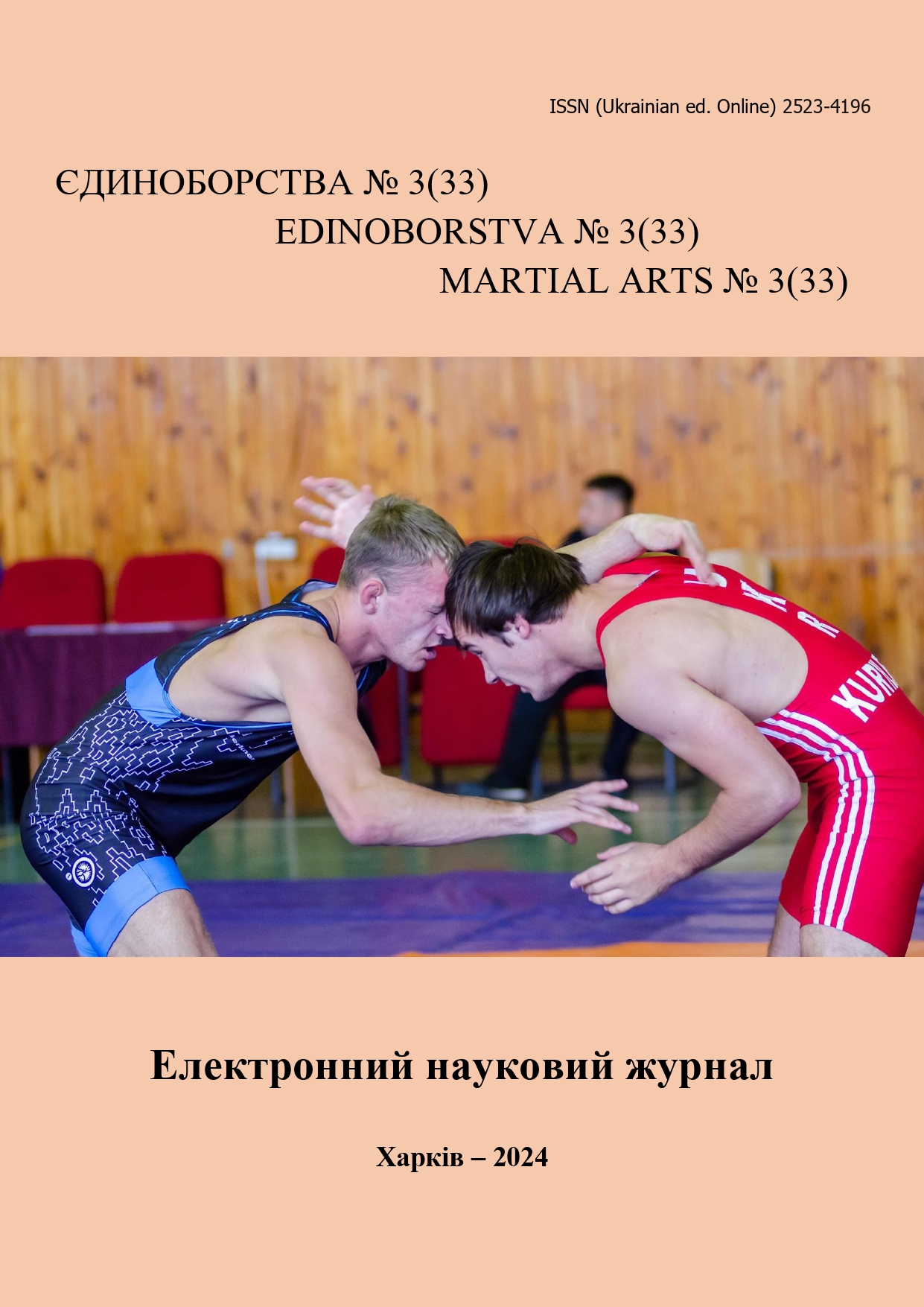The influence of martial arts training on the personality formation of higher education students
DOI:
https://doi.org/10.15391/ed.2024-3.08Keywords:
martial arts, higher education students, higher education institutions, personality, value orientationsAbstract
Purpose: to determine the role of martial arts in the process of forming a harmonious personality of higher education students in the People's Republic of China and Ukraine. Material and Methods. Theoretical and empirical research methods were used in the study: analysis of scientific and methodological literature and Internet sources, analysis of regulatory documents; comparative analysis; method of value orientations by M. Rokic; sociological survey (questionnaire); methods of mathematical statistics. Results: the study examines the peculiarities of the use of martial arts in higher education institutions of the People's Republic of China and Ukraine, conducts a sociological survey of higher education students of both countries regarding their attitude to practicing various types of martial arts, and compares the value orientations of students formed under the influence of martial arts. It turned out that in higher education institutions of the People's Republic of China, martial arts are included as a compulsory subject in the State Physical Education Program, while in Ukrainian higher education institutions, certain types of martial arts are introduced into the educational process by the decision of the management. The survey showed that higher education students in both countries consider martial arts to be popular sports and engage in these sports for harmonious development and health. Some terminal and instrumental values of higher education students in China and Ukraine are somewhat different, while the general value orientations and life principles of martial arts students are similar. Conclusions. Martial arts training has a positive effect on the harmonious development of higher education students. Under the influence of training, the level of physical development increases, a system of values aimed at personal growth and life wisdom is formed. Higher education students who are engaged in martial arts take care of their own health and personal development. They prioritize education, responsibility, strong will, and friendship, which indicate a desire for physical, intellectual, and moral and ethical growth. The results of the study make it possible to recommend martial arts training in higher education institutions in order to improve physical condition or achieve high sports results.References
Байрамов, Р.Х., & Бондар, А.С. (2019). Ціннісні орієнтації спортсменів сумо. Вісник Прикарпатського університету, 32, 3-9. DOI:10.15330/fcult.32.3-9
Бойченко, Н.В., & Голубничій, Р.В. (2016). Особливості фізичної підготовки спортсменок, що займаються дзюдо. Єдиноборства, 11-13. URL: https://core.ac.uk/download/pdf/229305521.pdf
Горбенко, О.В. (2018). Виховання ціннісних орієнтацій студентської молоді засобами східних єдиноборств. (Дис. на здобуття ….. канд. пед. наук). Харків, Україна.
Методика «Ціннісні орієнтації» (М. Рокича) (2015). Психологіс: Енциклопедія практичної психології - [Електронний ресурс]. - Режим доступу: http://psychologis.com.ua/metodika_cennostnye_orientacii_rokicha.htm (дата звернення: 25.03.2024).
Неприцька, Т.І. (2022). Формування ціннісних орієнтацій в суспільстві в умовах війни: реалії України. Політична культура та ідеологія: політичне життя, 3, 93-97. DOI:10.31558/2519-2949.2022.3.11
Ніколаєв, В.А., & Чіжаєв, П.І. (2020). Застосування засобів єдиноборств в системі фізичного виховання студенток закладів вищої освіти. Науковий часопис НПУ імені М.П. Драгоманова, 3 К (123), 282-285. DOI:10.31392/NPU-nc.series15.2022.3(148).27
Саєнко, В.Г. (2014). Біомеханічне вдосконалення ударної техніки у студентів університетів, які спеціалізуються зі східних єдиноборств. Вісник Чернігівського національного педагогічного університету імені Т.Г. Шевченка, 118, ІV, 185-188.
Саєнко, В.Г. (2009). Доцільність введення східних єдиноборств як навчальної дисципліни. Актуальні проблеми фізичного виховання в Україні, 221-228. DOI:10.13140/RG.2.2.11721.95848
Тропін, Ю., Романенко, В., Мирошниченко, Є., Джерелій, В., & Володченко, О. (2023). Особливості фізичної підготовки в різних видах єдиноборств (систематичний огляд). Єдиноборства, 3(29), 98-117 DOI:10.15391/ed.2023-3.09
Шапар, К.О., Коломєйцева, О.М. Довгопол, Е.П., & Гординський, Ю.С. (2022). Вплив занять єдиноборствами на фізичний розвиток студентів, їх силові здібності, витривалість та швидкість в умовах спортивного клубу ЗВО. Науковий часопис НПУ імені М.П. Драгоманова, 3(148), 124-131. DOI10.31392/NPU-nc.series15.2022.3(148).27
Bao, L.M. (2022). Research on the development of Wudang martial arts under the background of healthy China. Wushu Research, 7(10). 8-10. DOI: 10.1051/e3sconf/202129203047
Chang, Z., & Li, Y. (2018). Study on the Influence and Promotion of Chinese Traditional Martial Arts in Different Groups. Advances in Social Science, Education and Humanities Research, 250. 22-26. DOI: 10.2991/emim-18.2018.6
Chen, D., & Bondar, A. (2022). Popularization of chinese national traditional kinds of sports. Scientific Journal of National Pedagogical Dragomanov University Series 15 Scientific and pedagogical problems of physical culture (physical culture and sports), 6 (151), 9-13. DOI:10.31392/NPU-nc.series15.6(151).01
Iermakov, S., Podrigalo, L., Romanenko, V., Tropin, Y., & Kamaev, O. (2016) Psycho-physiological features of sportsmen in impact and throwing martial arts. Journal of Physical Education and Sport, 16(2), 67, 433-441. DOI:10.7752/jpes.2016.02067
John, C. Cox (1993). Traditional asian martial arts training: a review. Quest, 3(45). DOI:10.1080/00336297.1993.10484094
Podrihalo, O., Romanenko, V., Podrigalo, L., Iermakov, S., & Galimskyi, V. (2023) Evaluation of the functional state of taekwondo athletes 7-13 years old according to the indicators of the finger-tapping test. Slobozhanskyi Herald of Science and Sport. 27(1), 3-9. DOI:10.15391/snsv.2023-1.001
Sandford, G.T., & Gill, P.R. (2018). Martial arts masters identify the essential components of training. Physical Education and Sport Pedagogy, 24(1), 31-42. DOI:10.1080/17408989.2018.1530749
Wang, S.C. (2019). Analysis of the characteristics of chinese traditional sports culture in the new period. Journal of Sports Medicine and Therapy, 4, 053-060. DOI:10.29328/journal.jsmt.1001044
Zhang, T., Lim, B.H., Zhang, C., & Li, Ch. (2023). The Impact of Wushu Education on the Social Adaptability of Chinese University Students. 07th Asia-Pacific International Conference on Quality of Life Wina Holiday Villa, Kuta, Bali, Indonesia, 161-166. DOI:10.21834/e-bpj.v8i26.4954
Zhao, T. (2023). The role and influence of martial arts and taekwondo in the construction of sports culture in universities. Region - Educational Research and Reviews, 5(3), 157-163. DOI:10.32629/rerr.v5i3.1336













